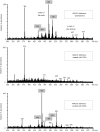Δ4-3-oxosteroid-5β-reductase deficiency: Responses to oral bile acid therapy and long-term outcomes
- PMID: 30809085
- PMCID: PMC6385010
- DOI: 10.3748/wjg.v25.i7.859
Δ4-3-oxosteroid-5β-reductase deficiency: Responses to oral bile acid therapy and long-term outcomes
Abstract
Background: Disorders of primary bile acid synthesis may be life-threatening if undiagnosed, or not treated with primary bile acid replacement therapy. To date, there are few reports on the management and follow-up of patients with Δ4-3-oxosteroid 5β-reductase (AKR1D1) deficiency. We hypothesized that a retrospective analysis of the responses to oral bile acid replacement therapy with chenodeoxycholic acid (CDCA) in patients with this bile acid synthesis disorder will increase our understanding of the disease progression and permit evaluation of this treatment regimen as an alternative to the Food and Drug Administration (FDA) approved drug cholic acid, which is currently unavailable in China.
Aim: To evaluate the therapeutic responses of patients with AKR1D1 deficiency to oral bile acid therapy, specifically CDCA.
Methods: Twelve patients with AKR1D1 deficiency, confirmed by fast atom bombardment ionization-mass spectrometry analysis of urine and by gene sequencing for mutations in AKR1D1, were treated with differing doses of CDCA or ursodeoxycholic acid (UDCA). The clinical and biochemical responses to therapy were monitored over a period ranging 0.5-6.4 years. Dose adjustment, to optimize the therapeutic dose, was based on changes in serum biochemistry parameters, notably liver function tests, and suppression of the urinary levels of atypical hepatotoxic 3-oxo-Δ4-bile acids measured by mass spectrometry.
Results: Physical examination, serum biochemistry parameters, and sonographic findings improved in all 12 patients during bile acid therapy, except one who underwent liver transplantation. Urine bile acid analysis confirmed a significant reduction in atypical hepatotoxic 3-oxo-Δ4 bile acids concomitant with clinical and biochemical improvements in those patients treated with CDCA. UDCA was ineffective in down-regulating endogenous bile acid synthesis as evidenced from the inability to suppress the urinary excretion of atypical 3-oxo-Δ4-bile acids. The dose of CDCA required for optimal clinical and biochemical responses varied from 5.5-10 mg/kg per day among patients based on maximum suppression of the atypical bile acids and improvement in serum biochemistry parameters, and careful titration of the dose was necessary to avoid side effects from CDCA.
Conclusion: The primary bile acid CDCA is effective in treating AKR1D1 deficiency but the therapeutic dose requires individualized optimization. UDCA is not recommended for long-term management.
Keywords: Bile acid synthesis disorder; Chenodeoxycholic acid; Mass spectrometry; Ursodeoxycholic acid; Δ4-3-oxosteroid-5β-reductase deficiency.
Conflict of interest statement
Conflict-of-interest statement: Setchell KD is a consultant to Retrophin San Diego, United States, and holds a minor equity in Asklepion Pharmaceuticals. The other authors declare no conflicts of interest.
Figures
Similar articles
-
Differential Feedback Regulation of Δ4-3-Oxosteroid 5β-Reductase Expression by Bile Acids.PLoS One. 2017 Jan 26;12(1):e0170960. doi: 10.1371/journal.pone.0170960. eCollection 2017. PLoS One. 2017. PMID: 28125709 Free PMC article.
-
Mutations in SRD5B1 (AKR1D1), the gene encoding delta(4)-3-oxosteroid 5beta-reductase, in hepatitis and liver failure in infancy.Gut. 2003 Oct;52(10):1494-9. doi: 10.1136/gut.52.10.1494. Gut. 2003. PMID: 12970144 Free PMC article.
-
Primary ∆4-3-oxosteroid 5β-reductase deficiency: two cases in China.World J Gastroenterol. 2012 Dec 21;18(47):7113-7. doi: 10.3748/wjg.v18.i47.7113. World J Gastroenterol. 2012. PMID: 23323017 Free PMC article.
-
Infant cholestasis patient with a novel missense mutation in the AKR1D1 gene successfully treated by early adequate supplementation with chenodeoxycholic acid: A case report and review of the literature.World J Gastroenterol. 2018 Sep 21;24(35):4086-4092. doi: 10.3748/wjg.v24.i35.4086. World J Gastroenterol. 2018. PMID: 30254413 Free PMC article. Review.
-
Chenodeoxycholic Acid: An Update on Its Therapeutic Applications.Handb Exp Pharmacol. 2019;256:265-282. doi: 10.1007/164_2019_226. Handb Exp Pharmacol. 2019. PMID: 31267167 Review.
Cited by
-
Efficacy and safety of switching therapy from chenodeoxycholic acid to cholic acid in Japanese patients with bile acid synthesis disorders.Mol Genet Metab Rep. 2024 Nov 22;41:101166. doi: 10.1016/j.ymgmr.2024.101166. eCollection 2024 Dec. Mol Genet Metab Rep. 2024. PMID: 39650085 Free PMC article.
-
Treatment of Inborn Errors by Product Replacement: The Example of Inborn Errors of Bile Acid Synthesis.J Inherit Metab Dis. 2025 Sep;48(5):e70081. doi: 10.1002/jimd.70081. J Inherit Metab Dis. 2025. PMID: 40847535 Free PMC article. Review.
-
Fat Malabsorption and Ursodeoxycholic Acid Treatment in Children With Reduced Organic Solute Transporter-α (SLC51A) Expression.JPGN Rep. 2022 Aug;3(3):e229. doi: 10.1097/pg9.0000000000000229. Epub 2022 Jul 25. JPGN Rep. 2022. PMID: 36148443 Free PMC article.
-
Healthy Patients With AKR1D1 Mutation Not Requiring Primary Bile Acid Therapy: A Case Series.JPGN Rep. 2023 Oct 9;4(4):e372. doi: 10.1097/PG9.0000000000000372. eCollection 2023 Nov. JPGN Rep. 2023. PMID: 38034430 Free PMC article.
-
∆4-3-oxo-5β-reductase deficiency: favorable outcome in 16 patients treated with cholic acid.Orphanet J Rare Dis. 2023 Dec 7;18(1):383. doi: 10.1186/s13023-023-02984-z. Orphanet J Rare Dis. 2023. PMID: 38062451 Free PMC article.
References
-
- Setchell KDR. Disorders of bile acid synthesis. In: Suchy FJSR, Balistreri WF, editors. Liver Disease in Children. Cambridge: Cambridge University Press; 2014.
-
- Setchell KD, Heubi JE. Defects in bile acid biosynthesis--diagnosis and treatment. J Pediatr Gastroenterol Nutr. 2006;43 Suppl 1:S17–S22. - PubMed
-
- Setchell KDR, Flick R, Watkins JB, Piccoli DA. Chronic hepatitis in a 10 yr old due to an inborn error in bile acid synthesis—diagnosis and treatment with oral bile acid. Gastroenterology. 1990;98:A578.
-
- Fischler B, Bodin K, Stjernman H, Olin M, Hansson M, Sjövall J, Björkhem I. Cholestatic liver disease in adults may be due to an inherited defect in bile acid biosynthesis. J Intern Med. 2007;262:254–262. - PubMed
MeSH terms
Substances
LinkOut - more resources
Full Text Sources
Medical


